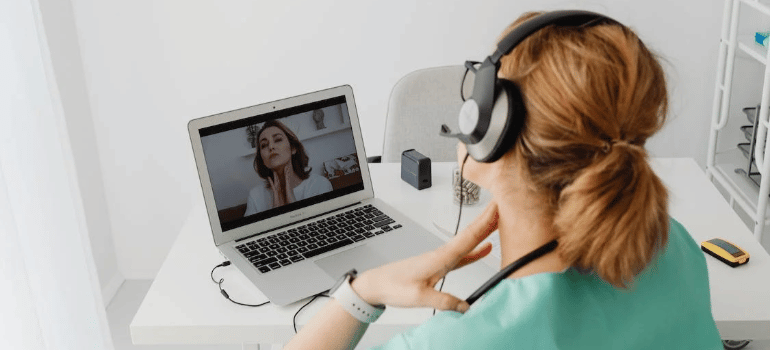Between the COVID-19 pandemic and the ongoing nationwide opioid epidemic, addiction treatment providers faced a bleak reality. Increased demand for rehab services clashed with safety measures and strained household budgets, rendering traditional rehab prohibitive for many. Within our state, too, our peers found themselves in dire need of adjusting decisively. It’s these conditions that accelerated telehealth, sparking the debate of in-person rehab in WV vs telehealth in public discourse.
As pioneers among rehab centers in West Virginia, we at Harmony Ridge Recovery have participated in this discussion. So, if this subject interests you, this article should help explore its fundamentals. It will outline exactly what each type of rehab is, who each suits best, and whether one is strictly superior.
Without further ado, let’s begin.
What is In-Person Rehab?
Sometimes dubbed “traditional” rehab, in-person rehab is exactly the kind of rehab most are used to. It’s the traditional approach to rehab, where the individual’s physical presence is required throughout. While this may vary considerably, depending on each individual case of addiction, it includes attending in-person and completing:
- Medical detox. First, it is medication assisted treatment West Virginia treatment providers suggest for virtually all moderate and severe cases of addiction. Medical detox is typically a necessity, as it allows the body to flush out substances and stabilize after withdrawal symptoms.
- Inpatient programs. The next step for cases which require clinical care comes in inpatient programs. Inpatient drug rehab in WV remains a prominent type of rehab, as it offers a safe and controlled clinical environment.
- Partial Hospitalization Programs (PHPs). Upon completing inpatient programs, some individuals still require some clinical care despite their progress. Such cases are often best suited for a partial hospitalization program West Virginia treatment providers offer as a step-down service, combining some hours of hospitalization with outpatient therapy.
- Intensive Outpatient (IOP) and Outpatient (OP) Programs. It is here where the debate of in-person rehab in WV vs telehealth can begin, as outpatient programs lend themselves to both. Both OPs and IOPs focus strongly on individual, group, and family therapy, allowing the individual to reintegrate into daily life. Between the two variants, it’s an intensive outpatient program West Virginia providers will typically suggest.
- Sober living home stays. Finally come sober living homes, as both the final step of rehab and a continuous step of aftercare. Stays in sober living WV facilities allow the individual to live among their peers, socialize, and maintain abstinence.

What Is Telehealth?
In contrast, as the name implies, telehealth hinges on remote healthcare through technology. The HHS explains, defining telehealth as follows:
“Telehealth — sometimes called telemedicine — lets your health care provider provide care for you without an in-person office visit. Telehealth is done primarily online with internet access on your computer, tablet, or smartphone.
There are several options for telehealth care:
- Talk to your health care provider live over the phone or video chat.
- Send and receive messages from your health care provider using secure messaging, email, secure messaging, and secure file exchange.
- Use remote monitoring so your health care provider can check on you at home.”
As such, telehealth can see uses for many types of remote healthcare. For rehab, too, it can serve as the primary means of healthcare services, across rehab types like:
- Alcohol rehab
- Cocaine rehab
- Stimulants rehab
- Heroin rehab
- Marijuana rehab
- Opiate rehab
- Meth rehab
- Fentanyl rehab
- Ambien rehab
- Barbiturates rehab
Of course telehealth extends beyond rehab specifically, but that goes beyond this article’s scope. If you would like to know more about telehealth, you may find the following HHS video of use:
In-person Rehab in WV vs Telehealth; Advantages of In-Person Rehab
That said, the two approaches are distinctly different as regards rehab, each coming with its own pros and cons.
Traditional, in-person rehab is demonstrably effective, as has been demonstrated by addiction treatment providers for decades. In the context of this specific comparison, too, it comes with some distinct advantages.
#1 Clinical Settings
First, in-person rehab offers clinical settings for MAT, Inpatient, and PHP programs. This advantage is crucial, as it allows for clinical services and supervision which remote settings don’t facilitate. It is particularly valuable in cases of dual diagnosis, where a Substance Use Disorder (SUD) may be found to co-occur with such mental health disorders as:
- Anxiety
- Bipolar disorder
- Depression
- Eating disorders
- Personality disorders and borderline personality disorders
- Schizophrenia
- Trauma
- Autism
- OCD
- ADHD
- PTSD
Dual diagnoses are far from uncommon, and actually make up many severe SUD cases. For reference, NIDA finds that 37.9% of adults with SUDs also have mental illnesses. In addition, it finds that 18.2% of adults with a mental illness also have an SUD.
#2 24/7 Supervision and Care
In turn, in-person rehab offers stronger, more consistent medical supervision. This is particularly valuable for such programs as MAT, Inpatient, and PHP programs, as it allows for:
- More consistent case management
- Safer pharmacotherapy as needed
- More thorough planning for aftercare programs
It is those offerings that make in-person rehab a better fit for more severe SUDs. In fact, in the in-person rehab in WV vs telehealth debate, it’s the option of MAT, inpatient, and PHP programs that gives in-person treatment a decisive edge for cases that require it.

#3 Group settings
Finally, in-person rehab comes with a very notable advantage as regards group therapy of any kind. That is, in-person rehab offers group settings for the individual to socialize and vocalize their struggles among peers. This advantage extends to such therapies as:
- Group therapy
- Family therapy
- Holistic addiction therapy with any kind of group-based practices
Granted, such therapies may not be necessary for all cases – although they tend to be invaluable. Some individuals may also work better in personal settings, especially earlier on during rehab. Still, leveraging group settings for rehab offers many benefits, and in-person rehab facilitates them much better than telehealth.
In-person Rehab in WV vs Telehealth; Advantages of Telehealth
All that said, telehealth does come with distinct advantages of its own. For many cases it isn’t just an alternative chosen by necessity, but a preferable one on its own merits. In the context of rehab and this comparison specifically, it comes with three main, virtually undeniable benefits.
#1 Accessibility
Initially, telehealth makes rehab accessible to those who may, for any reason, be unable to seek traditional therapy. Reasons might include a lack of nearby treatment facilities, long commute times, an inability to afford gas, and so on.
For such cases, telehealth may indeed be a very viable option. The HHS finds it can effectively deliver such behavioral therapies as:
- Cognitive Behavioral Therapy (CBT)
- Dialectic Behavior Therapy (DBT)
- Rational Emotive Behavior Therapy (REBT)
- Eye-Movement Desensitization and Reprocessing (EMDR)
Notably, these are the main therapy types employed during OP and IOP programs. As such, especially for milder cases of SUDs with few pharmacotherapy demands, one may attend a full program remotely. From admission to program completion, telehealth can indeed suffice for such cases.

#2 Pricing and Costs
The second advantage, as briefly touched on above, comes in final costs. It is no secret that rehab costs can be prohibitive for many, as DrugHelpline’s referential rehab cost estimates show:
- Drug Detox (30 days): $240–$850 per day
- Residential Treatment (duration varies): $5,100–$80,000
- Intensive Outpatient (30 days): $3,100–$10,000
- Outpatient Care (3 months): $1,450–$10,000
Final costs will of course vary among locations, treatment providers and facilities, and depend on health insurance coverage. Still, this is a crucial factor in the in-person rehab in WV vs telehealth debate; costs truly matter for many. By reducing clinical services, bypassing physical attendance, and focusing on personal therapy, telehealth’s offerings can be significantly more affordable.
#3 Flexibility
Finally, exactly because of its personal, one-to-one nature, telehealth can offer notable flexibility. Where in-person rehab and program attendance can be more rigid, telehealth largely leaves room for more fluid, convenient schedules.
This advantage can manifest in such individual-focused therapy types as:
Thus, telehealth can allow individuals with no physical access to rehab facilities to still receive therapy, bypassing commute time demands. It can similarly allow ones with busier schedules and responsibilities to adjust their therapy sessions to best suit their needs. In tandem with the accessibility perk outlined above, telehealth can make therapy more accommodating on the whole for many cases.
In-Person Rehab in WV vs Telehealth; Two Roads For Different Journeys
In brief, telehealth is indeed a viable alternative, especially for milder cases, as Healthline notes:
“While the parameters of virtual addiction treatment need further revision, the pandemic has shown that this is a viable and effective method of treatment delivery. […]Telehealth can provide additional levels of privacy and flexibility, which can draw certain people to the treatment, especially if it’s early on in the progression of the addiction.”

However, its perks do not give it a decisive edge over in-person rehab. On the contrary, in-person rehab remains the more efficient choice when it’s an option, especially for more severe cases. To summarize the two, we can assert that each can serve its own purpose in different journeys to recovery:
- Telehealth can offer access to rehab for those who lack the option of physical attendance
- Telehealth can be more affordable on the whole
- In-person rehab offers clinical services and more consistent supervision, making it ideal for more severe cases
- In-person rehab leverages group settings, which telehealth typically cannot do
- While both can be flexible, telehealth’s one-to-one settings tend to offer more for busier individuals
In brief, in-person treatment works particularly well in cases that require clinical settings, which telehealth cannot do. Conversely, telehealth can work very well for milder cases that primarily require therapy but physical access is hard or impossible. There is no strictly superior option between the two; each has its own perks and considerations, which can best facilitate different journeys.
In Summary
To summarize, the debate of in-person rehab in WV vs telehealth is quite complex and deep. For some, it may seem easy to dismiss telehealth as ineffective, despite all the data to the contrary. For others, telehealth may sound like a revolutionary panacea, which it isn’t either – as it cannot cater to all cases. As with all such matters, the truth seems to lie somewhere in the middle. Telehealth is a useful tool, but not one strictly superior to traditional in-person rehab; each facilitates its own journeys.
If you would like to know more about the vast subject of rehab approaches, please consider browsing our other content. If you now feel ready to seek help for you or your loved ones, please don’t hesitate to contact us. Our teams will set your mind at ease, and assist you professionally and discreetly with any concerns you might have. At Harmony Ridge Recovery, addiction treatment is our moral mission; every journey to recovery is a gift worth giving.



